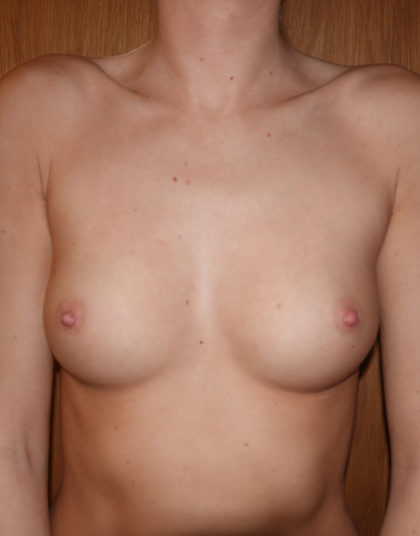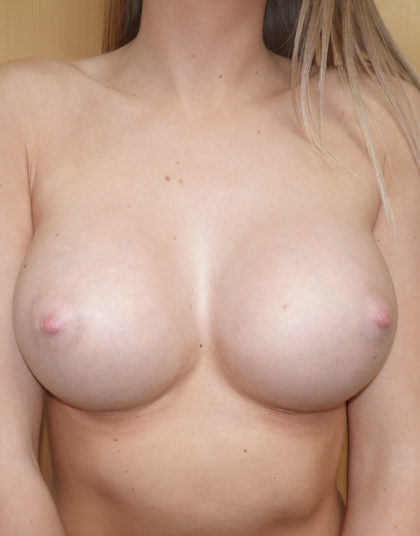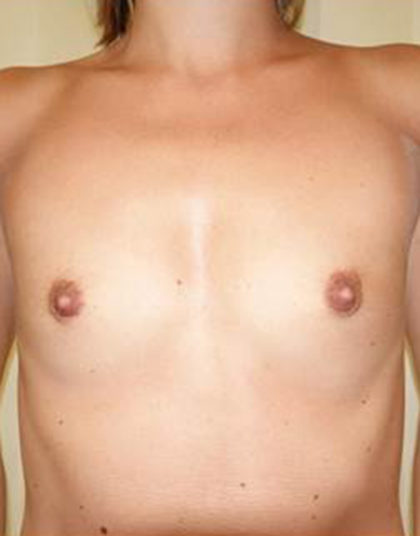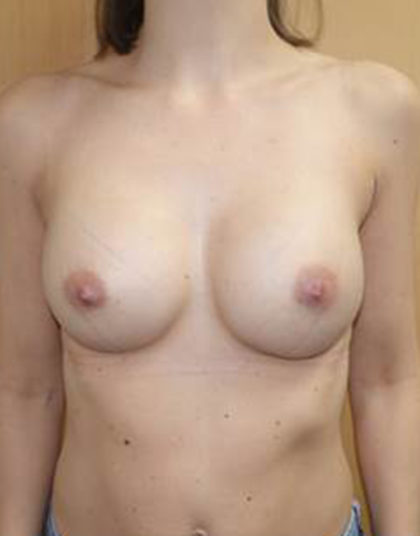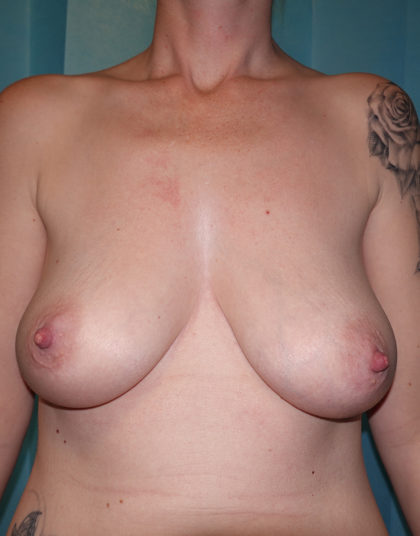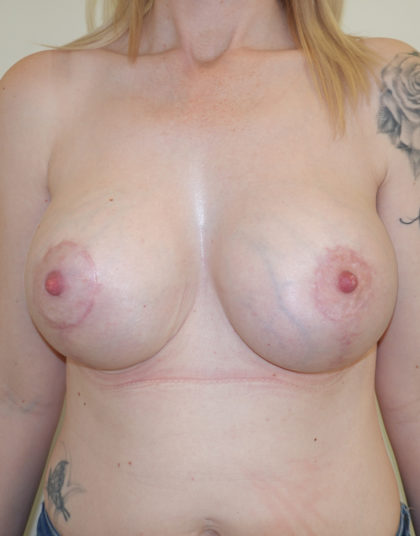Breast Implants for Tuberous Breast Correction
Conveniently located to serve the areas of London and Manchester

Tuberous breast correction with implants is a specialised procedure aimed at addressing the unique characteristics of tuberous breasts. Tuberous breasts, also known as constricted breasts, are a congenital condition where the breasts fail to develop fully during puberty. This can result in breasts that are smaller in size, with a narrow base and a higher, more constricted appearance.
At Harley Surgery, cosmetic surgeon-to-the-stars Dr. Riccardo Frati understands the impact that tuberous breasts can have on a woman’s self-esteem and body image. With his expertise in breast surgery and his commitment to achieving natural-looking results, he offers breast augmentation for tuberous breast correction.
To take the first step towards enhancing your breasts and boosting your confidence, contact Harley Surgery by calling +44 (0)20 3633 2619 or by filling out a form on our website. We have offices on Harley Street and Manchester. Our friendly staff will be happy to assist you in scheduling your appointment and answering any questions you may have.
Achieve the beautiful, symmetrical breasts you’ve always desired with the expertise of Dr. Frati and the team at Harley Surgery.
Before and After Photos
Contents
- 1 Book your consultation now
- 2 Before and After Photos
- 3 What Are Tuberous Breasts?
- 4 Can Implants Fix Tuberous Breasts?
- 5 Benefits of Implants for Tuberous Breast Correction
- 6 Candidates for Tuberous Breast Correction
- 7 Personal Consultation with Dr. Frati
- 8 Cost of Tuberous Breast Correction with Implants in London
- 9 FAQ
- 10 References
What Are Tuberous Breasts?
Tuberous breasts, also known as breast shape abnormality, is a specific type of breast condition that can affect both men and women. It is characterised by breasts that have a narrow base, are elongated in shape, and lack fullness in the lower pole (the base of the breast). In some cases, the areolas may be enlarged.
The appearance of tuberous breasts can vary from mild to severe, with more severe cases exhibiting significant asymmetry and a conical shape. Although the exact incidence of tuberous breasts is unknown, research indicates that up to 50% of women seeking breast augmentation or breast reduction have some degree of tuberosity. (1)
Women with tuberous breasts often experience a range of emotional and psychological challenges due to the perceived abnormality of their breast shape. These challenges may include low self-esteem, body image issues, and difficulties with clothing fit and finding bras that provide proper support.
Tuberous Breast Classification
Tuberous breasts can be classified using the Grolleau system, where breast hypoplasia (underdevelopment of tissue) is measured in the four quadrants of the breast. (2)
- Type I: Hypoplasia is noted in the medial lower quadrant only
- Type II: Hypoplasia is noted both lower quadrants
- Type III: Hypoplasia is noted in all four quadrants with severe breast constriction
Can Implants Fix Tuberous Breasts?
Fortunately, there are surgical options available to address tuberous breasts and restore a more natural breast shape. The specific treatment approach will depend on the severity of the condition and the desired outcome. In some cases, Dr. Frati may recommend a combination of procedures to achieve optimal results.
Breast Augmentation
Breast augmentation with implants is a common procedure used to correct tuberous breasts. This involves the insertion of silicone or saline implants to increase breast volume and improve overall shape. The implants can help fill out the lower pole of the breast and create a more rounded appearance.
Breast Uplift with Implants
In cases where the breast base is particularly narrow, Dr. Frati may perform a breast uplift or mastopexy in conjunction with augmentation. This procedure involves removing excess skin, reshaping the breast tissue, and repositioning the nipple to a more aesthetic position. By lifting and repositioning the breast tissue, a more balanced and symmetrical breast shape can be achieved.
Benefits of Implants for Tuberous Breast Correction
Enhanced Breast Shape and Symmetry
Tuberous breast correction using breast implants improves the shape and symmetry of the breasts, creating a more attractive and balanced appearance. By addressing the constricted breast tissue characteristic of tuberous breasts, the implants help achieve a natural-looking breast contour.
Corrected Nipple Placement
Tuberous breasts may have asymmetrical or misplaced nipples. Through tuberous breast correction with implants, the surgeon can correct these issues by repositioning the nipples, resulting in a more natural and symmetrical appearance.
Improved Clothing Fit
Tuberous breast correction using breast implants makes shopping for clothes easier and more enjoyable. With a more balanced and fuller breast shape, individuals find that clothes fit better, and they can confidently embrace styles that were previously avoided, opening up a world of fashion possibilities.
Improved Emotional Well-Being
The psychological impact of tuberous breasts can be significant, leading to feelings of insecurity and self-consciousness. Breast implants help alleviate these negative emotions, leading to improved emotional well-being and a more positive body image.
Personalised Treatment
Each individual’s tuberous breast condition is unique, and Dr. Frati ensures personalised treatment that addresses specific needs and desired outcomes. This tailored approach guarantees that patients receive customised treatment that optimally corrects tuberous breasts and delivers the best possible results.
Long-Lasting Results
Breast implants used in tuberous breast correction provide long-lasting results, allowing individuals to enjoy the benefits of their enhanced appearance for many years to come. With proper care and maintenance, the results can endure the test of time.
Candidates for Tuberous Breast Correction
Candidates for tuberous breast correction with implants are patients whose breasts are characterised by a constricted base, enlarged areolas, and a lack of fullness in the lower pole of the breast. Surgery is particularly pertinent for women experiencing a negative impact on their self-esteem and body image as a result of tuberous breasts. They may feel self-conscious about their appearance and desire to achieve a more proportionate and aesthetically pleasing breast shape.
It is essential for candidates to have realistic expectations regarding the outcomes of tuberous breast correction surgery. While significant improvements can be achieved, it is important to understand that individual results may vary based on each patient’s unique anatomy and the surgical techniques employed.
Personal Consultation with Dr. Frati
During your personal consultation at our state-of-the-art offices in London and Manchester, Dr. Frati will take the time to review your medical history and listen attentively to your cosmetic concerns. This initial step allows him to gain a deeper understanding of your unique situation, enabling him to provide personalised recommendations for your tuberous breast correction.
Dr. Frati will conduct a meticulous examination of your breasts, assessing the shape, size, and symmetry while considering the degree of tuberous deformity. Understanding the underlying structures of your breasts is crucial in determining the most effective surgical approach for your specific needs.
While breast implants can be an integral part of tuberous breast correction, it is important to note that each patient’s case is unique. Dr. Frati will discuss the options available to you, taking into account factors such as the severity of the tuberous deformity, your desired outcome, and your overall health. He may suggest a combination of surgical techniques, including breast augmentation with implants, breast uplift, nipple reshaping, or tissue redistribution, to achieve optimal results.
Cost of Tuberous Breast Correction with Implants in London
We believe in empowering our patients to make informed decisions about their aesthetic future. Therefore, after your personal consultation with Dr. Frati, you will receive a detailed estimate for the price of your procedure. Our goal is to help you experience the most effective rejuvenation techniques tailored to your individual needs.
If you are considering tuberous breast correction using implants, we invite you to contact us at +44 (0) 20 3633 2619 or visit our practice in London and Manchester. Dr. Frati and the dedicated team at Harley Surgery are committed to helping you achieve your aesthetic goals and providing you with the comprehensive information you need to make an informed decision.
Join Dr. Frati on Instagram and don’t forget to read his blog for more information about breast augmentation procedures at Harley Surgery.
FAQ
What causes tuberous breasts?
The underlying cause of tuberous breasts is not fully understood, but it is believed to be a result of abnormal growth and development during puberty. This abnormality can lead to insufficient breast tissue development and constriction of the base of the breast. As a result, the breasts fail to achieve the rounded, full appearance commonly associated with a typical breast shape.
Is surgery the only option for tuberous breast correction?
Surgery is the most effective and reliable option for tuberous breast correction. While there are non-surgical alternatives available, such as fat grafting or the use of injectable fillers, these options typically provide temporary results and may not adequately address the underlying structural issues associated with tuberous breasts.
How can implants help with tuberous breast correction?
Breast implants can play a crucial role in tuberous breast correction. By inserting implants, we can enhance the volume and shape of the breasts, creating a more symmetrical and aesthetically pleasing appearance. The implants help to expand the breast tissue, correcting the constricted shape and providing a fuller, more natural contour.
References
- Grella R, D’Andrea F, Giovanni Francesco Nicoletti, Lanzano G. Tuberous Breast Management: A Review of Literature and Novel Technique Refinements. 2022;10(12):e4708-e4708. doi:https://doi.org/10.1097/gox.0000000000004708
- Claudio Silva-Vergara C, Fontdevila J, Weshahy O. Fat Grafting Technique, A Paradigm Shift in the Treatment of Tuberous Breast. World journal of plastic surgery. 2018;7(1):72-77. https://www.ncbi.nlm.nih.gov/pmc/articles/PMC5890369/











